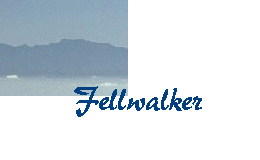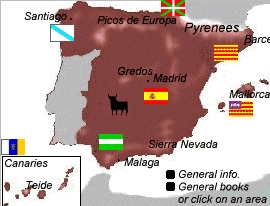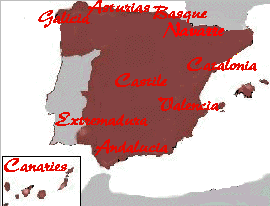
 SPAIN
- WALKING - FOOD
SPAIN
- WALKING - FOODMountain weather
History
Language
Spanish food and eating hours
Introduction
 Spain is
a common destination for the package holiday trade, but there is much
more
to this country than sitting on a beach. Move away from the holiday
complexes
down the coasts and in minutes you are in a different land, unaffected
by the dubious benefits of the mass tourism that came to Spain in the
sixties.
During the long years of Franco's reign
Spain fell behind the rest of Europe's post war development, (which
makes
it cheaper to visit than some european countries) but once Franco died
and democracy arrived, Spain started to party, and they have never
stopped!
For the walker this country offers high mountains in all parts of the
country.
In high summer the temperature is likely to be hot (at least in
valleys)
so it may be best to avoid the hottest months.
Spain is
a common destination for the package holiday trade, but there is much
more
to this country than sitting on a beach. Move away from the holiday
complexes
down the coasts and in minutes you are in a different land, unaffected
by the dubious benefits of the mass tourism that came to Spain in the
sixties.
During the long years of Franco's reign
Spain fell behind the rest of Europe's post war development, (which
makes
it cheaper to visit than some european countries) but once Franco died
and democracy arrived, Spain started to party, and they have never
stopped!
For the walker this country offers high mountains in all parts of the
country.
In high summer the temperature is likely to be hot (at least in
valleys)
so it may be best to avoid the hottest months.
Click on the titles or on the map to look at some possible walking holiday destinations.
Spain is a high plateau or tableland (the meseta) with ranges of mountains (Cordillera Cantabrica and Pyrenees) across the north dividing it from France and in the south, the spanish mainland's highest mountains, the Sierra Nevada. Much of the interior is above 900 metres above sea level and many mountain ranges rise above 1800 metres.The capital, Madrid is in the centre of the peninsula. There is a strong regionalist culture, especially in Catalonia (capital Barcelona) and the Basque country in the north.
The population tends to be crowded together in towns with large areas of countryside almost devoid of houses. This situation developed in the days when banditry in the countryside was commonplace but seems to have become part of the spanish character.
Climate is rather variable being influenced by both the Mediterranean and the Atlantic, the interior has hot dry summers and is generally sunny at all times but the cold winters often bring snow to higher ground. .
| Madrid | Jan | Feb | Mch | Apr | May | June | July | Aug | Sept | Oct | Nov | Dec |
| Av Max (C) | 9 | 11 | 15 | 18 | 21 | 27 | 31 | 30 | 25 | 19 | 13 | 9 |
| Precip mm | 39 | 34 | 43 | 48 | 47 | 27 | 11 | 15 | 32 | 53 | 47 | 48 |
The south and east coasts and Balearic Islands have the Mediterranean climate beloved of the summer holidaymaker. The northern coasts are wetter and more humid than the south.
East coast
| Barcelona | Jan | Feb | Mch | Apr | May | June | July | Aug | Sept | Oct | Nov | Dec |
| Av Max (C) | 13 | 14 | 16 | 18 | 21 | 25 | 28 | 28 | 25 | 21 | 16 | 13 |
| Precip mm | 31 | 39 | 48 | 43 | 54 | 37 | 27 | 49 | 76 | 86 | 52 | 45 |
South coast
| Almeria | Jan | Feb | Mch | Apr | May | June | July | Aug | Sept | Oct | Nov | Dec |
| Av Max (C) | 16 | 16 | 18 | 20 | 22 | 26 | 29 | 29 | 27 | 23 | 19 | 17 |
| Precip mm | 31 | 21 | 21 | 28 | 18 | 4 | 0 | 6 | 16 | 25 | 27 | 36 |
The
mountainous north ("green Spain") is a lot wetter than elsewhere,
particularly
the Basque country.
| Santander | Jan | Feb | Mch | Apr | May | June | July | Aug | Sept | Oct | Nov | Dec |
| Av Max (C) | 12 | 12 | 14 | 15 | 17 | 20 | 22 | 22 | 21 | 18 | 15 | 13 |
| Precip mm | 119 | 88 | 78 | 83 | 89 | 63 | 54 | 84 | 114 | 133 | 125 | 159 |
Mountain
weather
The
Cordillera Cantabrica and the Sierra Grazalema bear the brunt of
Atlantic
moist air and are likely to have precipitation at any time. The
Pyrenees
are subject to violent storms, often in the afternoons/evenings in my
experience.
Mid June to September is the summer walking window. Winter snow
(possible
September to July) lasts through the summer on the highest ground
although
the Sierra Nevada was completly devoid of snow the year they tried to
host
the winter Olympics. Inland Andalucia can be too hot for low level
walking
in high summer. The Canaries are warm all year round and Teide is the
only
mountain likely to hold snow. The winter is more pleasant for walking
due
to cooler temperatures.
A partial history
First a colony of Carthage, "Hispania" became part of the Roman empire as Tarraconensis, Lusitania and Baetica. In the 4th and 5th centuries the barbarian attacks on the Roman empire commenced and Vandals swept down through Iberia and into north Africa. Toledo became the capital of Visigoth Iberia.
The next invasion came not from the north but the south. The muslims, in 711. After advancing as far as Poitier in France they were gradually pushed back by christian forces and by 950 muslim rule holds sway only in the southern half of the peninsula under the control of the caliphate of Cordoba (in what the moors now called "Al Andalus" from the vandals "Vandalucia") although christian and jew are tolerated under their rule. The moors irrigated the land and cleared forests for charcoal and crops and sheep and goats were introduced to the cleared land.
The front-line christian kingdoms of the north are now Castile, Aragon and Portugal (many town names in Spain were suffixed "de la frontera" from this period of shifting frontiers). The militant christianity that gave birth to the crusades kept pushing back the muslim empire and by 1212 only Extremadura, Andalucia, Murcia and Valencia were still under moorish control.
In 1469 Ferdinand of Aragon (born 1452 in Sos del Rey Catolico
In 1517 Carlos I assumed the crowns of Aragon and Castile, thus uniting Spain (except for Portugal, which although an independent kingdom from 1139, has to fight the battle of Ajubarrota in 1385 to assert its independence and then have to rise in revolt in 1640 after Philip II of Spain had assumed control on the demise of the Portuguese ruling house.).
| At the same time as the final reconquest Columbus was discovering the Americas and the period of spanish trade and empire in central and south America began. By 1700 Spain controlled as far north as San Francisco with Portugal in control of Brazil. Many new foods like peppers, chilli, chocolate, potatoes and tomatoes were brought back to the old world and found their way into spanish cooking. The conquistadors, returning laden with gold, built many palaces, often in their native Extremadura. |
Many
fine moorish building remain in Spain including The Alhambra in Grenada
and The Mezquita![]() in Cordoba (albeit with a christian cathedral in the centre) and the
cuisine
of places such as Cordoba have
strongly
mozarabic styles.
in Cordoba (albeit with a christian cathedral in the centre) and the
cuisine
of places such as Cordoba have
strongly
mozarabic styles.
Many
converted moors remained in christian Spain under the Inquisition but
in
later centuries further expulsions of jews and moors took place. The
gaps
left in Andalusian society by these expulsions were often taken up by a
only slightly less persecuted minority, the gypsies (gitanos).
Many
gypsies were only able to be accepted into Andalusian society because
of
their war records in the Flemish campaigns and by chance it seems they
gained the name "Flamencos". The music of the gitanos found an echo in
the music of the native Andalusian ("payo" to the gypsies) and the
phenomenon
that is Flamenco was born.
In
the early 19th Century most of Spain's colonies gain independence and
by
1807 Napoleonic forces have occupied Spain only to be driven out in the
spanish war of independence, known as the Peninsula war in the UK.
British
troops fought under the Duke of Wellington who was given land near
Granada
and the title of Duke of Cuidad Rodrigo in gratitude after the victory
at Salamanca.
Remaining
colonies are then lost to America in the Spanish-American war. After a
civil war in 1833-40 the first republic is formed but soon followed by
the restoration of the monarchy. A coup in 1923 saw Primo de Rivera as
dictator (with Alphonso XIII as king) until economic decline led to
resignation
and the second republic and elections in 1936. The leftist Popular
Front
came to power but was unacceptable to the monarchists and the Falange,
formed by Rivera's son.Then, (ironically almost
500
years after the moors were driven from Spain) General Francisco Franco
(1892-1975) invaded Spain using Islamic mercenaries from the Spanish
colony
in Morocco to begin the Spanish Civil war (1936-39). Franco was
supported
by the fascists in Germany and Italy but non fascist western europe did
little to support the beleaguered republican government who depended on
aid from the communist Soviet Union. However, ordinary people, often
trade
unionists or communists, did go to Spain's aid to serve in the
International
Brigades, but to no avail. Divided and poorly armed town after town
fell
to the Nationalists. The destruction of the Basque town of Guernica in
1937 by German aircraft inspired Picasso's painting of the same name.
In
1939 Barcelona fell to Franco, followed by Madrid. Three quarters of a
million spaniards died in the war.
Franco's
dictatorship did not end until his death in 1975 when King Juan Carlos
(grandson of Alfonso
XIII)
took over as his nominated and groomed successor but to the displeasure
of conservative elements soon introduced a new age of democracy. A coup
was attempted in 1981 in which the Cortes was seized but the new King
appeared
on television calling for support for the legitimate elected government
(while telephoning generals to insist they must support democracy).
This
made him the hero of the people and even previously critical communists
declared "God save the King" and "We are all monarchists now!". If you
tour Spain you will soon start to see framed photos of the King,
visiting
hotels, opening hospitals or inspecting local culinary specialities.
 Spanish
food
Spanish
food While you are in Spain you have an opportunity to try the varied cuisine. From the roast meats of the centre, fried fish of the south, rice dishes of the east and in the north, in the Basque country, cooking!
Eating hours
In touristy areas and northern european enclaves you may well find restaurants catering to non spanish mealtimes. But once away from those areas you will find very different timings from those you are used to. Breakfast should not be a problem as it is likely to run from early through to the late "second breakfast". Lunchtime, work permitting, will tend to be late, around 2pm and you may find places where some people are still eating lunch after 4pm! Similarly dinner is late, very late. Some places will start to open from 8pm but will generally be empty at first. Don't expect to see them fill up until after 9pm and its not at all uncommon, especially in summer and at weekends for people to be still eating dinner after midnight. If you want to eat earlier you can resort to tapas bars which will be open at northern european dinner times, but that will be to miss the best of the atmosphere and part of the experience. Just imagine you have entered a different time zone and of course don't go straight to bed after that late meal! Not enough sleep? Take a siesta!
Click on the map for a taste of Spain
Some say Africa starts at the Pyrenees, I think friendly people start at the Pyrenees!